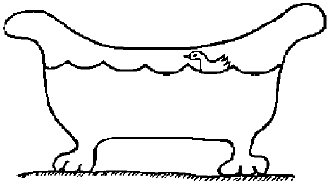BACKGROUND:
Stresses within the crust and upper mantle of the
Earth causes earthquakes. The stress includes movement of molten rock and
the slow movement of the upper mantle and crust.
The stress builds up in rocks. However, rocks
eventually break, and the stored stress is released as energy in the form of
earthquakes. Energy is the transfer of movement through a system. In the
case of the Earth, the transfer of energy can be great, and can extend this
over large distances. For instance, if you drop a pebble in a tub of water,
you will notice that as the pebble hits the water, waves of
"energy" migrate away from the initial drop. These
"rings" of energy are transferring the force of the impact of the
pebble a great distance from where it hit the water.
The energy released during an earthquake migrates away
from the focus of the earthquake (location of the first break of the rocks)
as waves. These waves are called seismic waves.
In this Pre Lab, the students will learn that there
are many ways that energy is released in our everyday lives. Even in the
bathtub! This exercise also gets students to think about the connection
between waves and energy.
PROCEDURE:
- Explain to the class that energy is released by earthquakes. It is
this energy, in the form of seismic waves, that we feel when the Earth
"shakes."
 Draw the diagram
on the board. Notice that the bathtub is clear.
Ask the students what will happen to the rubber ducky if someone jumps
into the bath tub? Draw the diagram
on the board. Notice that the bathtub is clear.
Ask the students what will happen to the rubber ducky if someone jumps
into the bath tub?
After getting their answers, ask the students to imagine being a body of
energy. The energy that he or she emits when he/she jumps in the tub
creates waves. Waves are the expression of energy as it goes through the
water. The larger the person jumping in the tub, the larger the wave
will be. If a person runs and jumps into the tub, there will be more
energy, and hence, the waves will be larger. Emphasize that the rubber
ducky will bob up and down because of the energy.
- Explain that earthquakes emit energy that moves along in waves,
similar to the water in the bathtub. You may want to perform a
demonstration by using a large pan of water and pebbles, partly to show
technique and partly to show energy "radiation" over larger
water surfaces than in a cup.
- If you have completed step 3, have the students repeat the
demonstration using cups, water, and pebbles. Give them a pebble or
other object and have them drop it from different heights into a cup
half full of water. They should notice that the greater the height from
which they drop the pebble, the bigger the "waves" created.
Emphasize that when energy is released, this energy can be transmitted
by waves. Remind the students that when an earthquake occurs, it
releases energy through waves. This exercise can be repeated on a large
scale outside. The energy wave might get a little high!
|